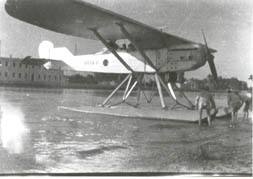Related Research Articles

The SIAI S.8 was an Italian 1910s two-seat reconnaissance flying boat.

The Breda A.7 was a reconnaissance aircraft developed in Italy for use by the Regia Aeronautica in 1929. It was a braced parasol monoplane of conventional configuration with tailskid undercarriage. The pilot and observer sat in tandem, open cockpits. A single prototype of a long-range example, originally designated A.7 Raid and later A.16 was also constructed, but the air force showed no interest in it.

The Caproni Ca.135 was an Italian medium bomber designed in Bergamo in Italy by Cesare Pallavicino. It flew for the first time in 1935, and entered service with the Peruvian Air Force in 1937, and with the Regia Aeronautica in January 1938.

The Caproni Ca.165 was an Italian biplane fighter developed just before World War II, but produced only as a prototype, as the competing Fiat CR.42 Falco was selected for series production.

The Savoia-Marchetti SM.78 was an Italian bomber/reconnaissance biplane flying boat of the early 1930s.

The Savoia-Marchetti SM.62 was an Italian single-engine maritime patrol flying boat produced from 1926. It served with the Regia Aeronautica and with a number of foreign users, and was licence-produced in Spain and the Soviet Union. Some of the Spanish aircraft were still in service during the Spanish Civil War

The Caproni Ca.111 was a long-range reconnaissance aircraft and light bomber produced in Italy during the 1930s. It was a derivative of the Ca.101.

The Breda Ba.201 was an Italian dive bomber designed during World War II, that never entered production.
The Piaggio P.32 was an Italian medium bomber of the late 1930s, produced by Piaggio, and designed by Giovanni Pegna. It was a modern design for its time, but was a failure due to lack of powerplants commensurate with its high wing loading.

The Caproni Ca.355 Tuffo was a low-wing single-engine dive bomber, designed and built by the Italian Caproni company in 1941, which never proceeded beyond a single prototype. Derived from Ca.335 Mistral, the Ca.355 was proposed to equip the Regia Aeronautica, but it was found to offer little advantage over the German Junkers Ju 87 "Stuka" and the project was abandoned.

The Caproni Vizzola F.6 was a World War II-era Italian fighter aircraft built by Caproni. It was a single-seat, low-wing cantilever monoplane with retractable landing gear. Only two prototypes were built, one designated F.6M and the other designated F.6Z.

The Caproni Ca.331 Raffica was an Italian aircraft built by Caproni in the early 1940s as a tactical reconnaissance aircraft/light bomber and also as a night fighter.

The Caproni Ca.90 was a prototype Italian heavy bomber designed and built by Caproni. When it first flew in 1929 it was the largest land-based aircraft in the world.

The Caproni Ca.87 was an Italian flying boat built in the 1920s for a planned transatlantic flight.
The Caproni Ca.66 and Caproni Ca.67 were Italian night bomber aircraft designed to re-equip the post-World War I Regia Aeronautica.
The Caproni Ca.79 was an Italian light bomber produced in the mid-1920s.
The Caproni Ca.120 was a three-engine monoplane bomber built by Caproni in the 1930s.
The Caproni Ca.127 was a single-engine reconnaissance monoplane built by Caproni in the mid-1930s.
The Caproni Ca.146 was a high-wing reconnaissance aircraft built by Caproni in the mid-1930s.
The Caproni Ca.225 was a twin-engine attack bomber design proposed by Caproni in the mid-1930s.
References
- ↑ Thompson, Jonathon W. (1963). Italian Civil and Military Aircraft 1930–1945 . USA: Aero Publishers Inc. p. 118. ISBN 0-8168-6500-0.